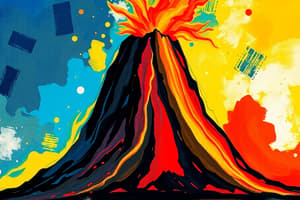Podcast
Questions and Answers
How are Composite Cone Volcanoes different from Cinder Cone Volcanoes?
How are Composite Cone Volcanoes different from Cinder Cone Volcanoes?
- Composite Cone Volcanoes have low silica content, while Cinder Cone Volcanoes have high silica content.
- Composite Cone Volcanoes are small, while Cinder Cone Volcanoes are large.
- Composite Cone Volcanoes are formed near or inside large volcanoes, and Cinder Cone Volcanoes are produced by alternating layers of lava and pyroclastic materials.
- Composite Cone Volcanoes are made of alternating layers of lava and pyroclastic materials, whereas Cinder Cone Volcanoes are built from ejected lava fragments. (correct)
What is the function of a Side Vent on a volcano?
What is the function of a Side Vent on a volcano?
- To store molten rock beneath the volcano's main vent.
- To erupt through the Earth's surface creating lava flows.
- To build alternate layers of lava and pyroclastic materials.
- To release ash and gas clouds during a volcanic eruption. (correct)
Which part of a volcano is responsible for holding the hot liquid rock beneath the Earth's surface?
Which part of a volcano is responsible for holding the hot liquid rock beneath the Earth's surface?
- Magma Chamber (correct)
- Crater
- Summit
- Base
Which type of volcano is characterized by the slow extrusion of viscous lava resulting in circular, mound-shaped protrusions?
Which type of volcano is characterized by the slow extrusion of viscous lava resulting in circular, mound-shaped protrusions?
What type of eruptions are characterized by lava fountains and the ejection of egg-shaped materials?
What type of eruptions are characterized by lava fountains and the ejection of egg-shaped materials?
Which type of volcano is unlikely to erupt again based on geological assessments and historical records?
Which type of volcano is unlikely to erupt again based on geological assessments and historical records?
What does PHIVOLCS stand for?
What does PHIVOLCS stand for?
Which geophysical technique monitors the conductivity of rocks underneath the Earth to indicate volcanic activity?
Which geophysical technique monitors the conductivity of rocks underneath the Earth to indicate volcanic activity?
What is the purpose of using Satellite Remote Sensing Systems in the context of the text?
What is the purpose of using Satellite Remote Sensing Systems in the context of the text?
A volcano is a mountain that opens downward to a pool of molten rock known as ____________.
A volcano is a mountain that opens downward to a pool of molten rock known as ____________.
The highest point or apex of a volcano is called the ____________.
The highest point or apex of a volcano is called the ____________.
The region beneath the vent of a volcano where molten rock or magma is stored is known as the Magma ____________.
The region beneath the vent of a volcano where molten rock or magma is stored is known as the Magma ____________.
Composite Cone Volcanoes, also known as stratovolcanoes, are produced when viscous lava of andesitic composition flows out. A mound is built from alternating layers of lava and ____________ materials.
Composite Cone Volcanoes, also known as stratovolcanoes, are produced when viscous lava of andesitic composition flows out. A mound is built from alternating layers of lava and ____________ materials.
______ Volcano is formed by less viscous basaltic lava flows.
______ Volcano is formed by less viscous basaltic lava flows.
Lava Dome eruptions may be weak or extremely violent and are characterized by ______ fountains.
Lava Dome eruptions may be weak or extremely violent and are characterized by ______ fountains.
Pelean eruptions have high water and ______ content.
Pelean eruptions have high water and ______ content.
Phreatomagmatic eruptions result from ejection of magmatic gases and steam produced by the conversion of groundwater to steam by ascending ______.
Phreatomagmatic eruptions result from ejection of magmatic gases and steam produced by the conversion of groundwater to steam by ascending ______.
Plinian eruptions are characterized by voluminous ejections of pumice and ______ flows.
Plinian eruptions are characterized by voluminous ejections of pumice and ______ flows.
Active Volcanoes have erupted during the ______.
Active Volcanoes have erupted during the ______.
Flashcards are hidden until you start studying




